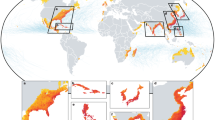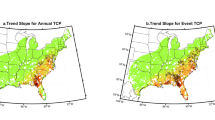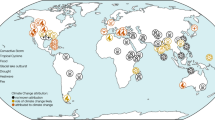Abstract
The impact of tropical cyclones on humans depends on the number of people exposed and their vulnerability, as well as the frequency and intensity of storms. How will the cumulative effects of climate change, demography and vulnerability affect risk? Conventionally, reports assessing tropical cyclone risk trends are based on reported losses, but these figures are biased by improvements to information access. Here we present a new methodology based on thousands of physically observed events and related contextual parameters. We show that mortality risk depends on tropical cyclone intensity, exposure, levels of poverty and governance. Despite the projected reduction in the frequency of tropical cyclones, projected increases in both demographic pressure and tropical cyclone intensity over the next 20 years can be expected to greatly increase the number of people exposed per year and exacerbate disaster risk, despite potential progression in development and governance.
This is a preview of subscription content, access via your institution
Access options
Subscribe to this journal
Receive 12 print issues and online access
$209.00 per year
only $17.42 per issue
Buy this article
- Purchase on Springer Link
- Instant access to full article PDF
Prices may be subject to local taxes which are calculated during checkout





Similar content being viewed by others
References
EM-DAT: The OFDA/CRED International Disaster Database http://www.emdat.be (2011).
Tobin, G. A. & Montz, B. E. Natural Hazards: Explanation and Integration (Guilford Press, 1997).
United Nations Disaster Relief Coordinator Natural Disasters and Vulnerability Analysis in Report of Expert Group Meeting 8–9 (UNDRO, 1979).
http://www.preventionweb.net/english/professional/terminology/?pid:6&pih:2.
Coburn, A. W., Spence, R. J. S. & Pomonis, A. Vulnerability and risk assessment. UNDP Disaster Management Training Program Vol. 57 (1997).
Knutson, T. R. et al. Tropical cyclones and climate change. Nature Geosci. 3, 157–163 (2010).
Elsner, J. B., Kossin, J. P. & Jagger, T. H. The increasing intensity of the strongest tropical cyclones. Nature 455, 92–95 (2008).
Bender, M. A. et al. Modeled impact of anthropogenic warming on the frequency of intense Atlantic hurricanes. Science 327, 454–458 (2010).
Peduzzi, P., Dao, H., Herold, C. & Mouton, F. Assessing global exposure and vulnerability towards natural hazards: The Disaster Risk Index. Nat. Hazard. Earth Syst. Sci. 9, 1149–1159 (2009).
World Bank Development Actions and the Rising Incidence of Disasters, Evaluation Brief #4 (Independent Evaluation Group, the World Bank, 2007).
ESCAP, UNISDR Protecting Development Gains, Reducing Disaster Vulnerability and Building Resilience in Asia and the Pacific (ESCAP, UNISDR, 2010).
IFRC World Disasters Report: Focus on Early Warning, Early Action(IFRC, 2009).
ICHARM, UNESCO Global Trends in Water-Related Disasters: An Insight for Policymakers (ICHARM, UNESCO, 2009).
DARA Climate Vulnerability Monitor 2010: The State of the Climate Crisis (Development Assistance Research Associates (DARA), 2010).
Knapp, K. R., Kruk, M. C., Levinson, D. H., Diamond, H. J. & Neumann, C. J. The International Best Track Archive for Climate Stewardship (IBTrACS): Unifying tropical cyclone best track data. Bull. Am. Meteorol. Soc. 91, 363–376 (2010).
Paul, B. K. Why relatively fewer people died? The case of Bangladesh’s Cyclone Sidr. Nat. Hazard. 50, 289–304 (2009).
Webster, P. J. Myanmar’s deadly daffodil. Nature Geosci. 1, 488–490 (2008).
Landsea, C. W., Harper, B. A., Hoarau, K. & Kaff, J. Can we detect trends in extreme tropical cyclones? Science 313, 452–454 (2006).
United Nations Population Division, Population 1960–2010 http://geodata.grid.unep.ch/.
Raftery, A. E. et al. White Paper: Probabilistic Projections of the Total Fertility Rate for all Countries for the 2010 World Population Prospects (2009); available at http://www.un.org/esa/population/meetings/EGM-Fertility2009/P16_Raftery.pdf.
Holland, G. J. An analytic model of the wind and pressure profiles in hurricanes. Mon. Weath. Rev. 108, 1212–1218 (1980).
Willoughby, H. E. & Rahn, M. E. Parametric representation of the primary hurricane vortex. Part I: Observations and evaluation of the Holland (1980) model. Mon. Weath. Rev. 132, 3033–3048 (2004).
Willoughby, H. E., Rahn, M. E. & Darling, R. W. R. Parametric representation of the primary hurricane vortex. Part II: A new family of sectionally continuous profiles. Mon. Weath. Rev. 134, 1102–1120 (2006).
Holland, G. A revised hurricane pressure–wind model. Mon. Weath. Rev. 136, 3432–3445 (2008).
Davidson, R., Zhao, H. & Kumar, V. Quantitative model to forecast changes in hurricane vulnerability of regional building inventory. J. Infrastruct. Syst. 9, 55–64 (2003).
Vickery, P. J., Skerlj, P. F., Steckley, A. C. & Twisdale, L. A. Hurricane wind field model for use in hurricane simulations. J. Struct. Eng. 126, 1203–1221 (2000).
Jain, V. K., Davidson, R. & Rosowsky, D. Modelling changes in hurricane risk over time. Nat. Hazard. Rev. 6, 88–96 (2005).
Apivatanagul, P., Davidson, R., Blanton, B. & Nozick, L. Long-term regional hurricane hazard analysis for wind and storm surge. Coast. Eng. 58, 499–509 (2011).
Poulos, H. M. Spatially explicit mapping of hurricane risk in New England, USA using ArcGIS. Nat. Hazard. 54, 1015–1023 (2010).
Rumpf, J., Weindl, H., Höppe, P., Rauch, E. & Schmidt, V. Tropical cyclone hazard assessment using model-based track simulation. Nat. Hazard. 48, 383–398 (2008).
Legg, M. R., Nozick, L. K. & Davidson, R. A. Optimizing the selection of hazard-consistent probabilistic scenarios for long-term regional hurricane loss estimation. Struct. Safety 32, 90–100 (2010).
Esteban, M. & Longarte-Galnares, G. Evaluation of the productivity decrease risk due to a future increase in tropical cyclone intensity in Japan. Risk Anal. 30, 1789–1802 (2010).
Vickery, P. J., Masters, F. J., Powell, M. D. & Wadhera, D. Hurricane hazard modelling: The past, present, and future. J. Wind Eng. Ind. Aerodyn. 97, 392–405 (2009).
Peduzzi, P., Dao, H. & Herold, C. Mapping disastrous natural hazards using global datasets. Nat. Hazard. 35, 265–289 (2005).
Landscan, Oak Ridge National Laboratory, http://www.ornl.gov/sci/landscan/.
Acknowledgements
U. Deichmann (World Bank) for providing the GDP distribution; A. Maskrey (United Nations International Strategy for Disaster Reduction) for finding the finances to supporting this study; R. Harding for English corrections.
Author information
Authors and Affiliations
Contributions
P.P. developed the methodology, carried out the multiple-regression risk analysis, including trend and spatial risk distribution, and developed the MRI with H.D. B.C., C.H. and O.N. generated the spatial model for the TC buffers and extracted the human and economic exposure as well as contextual parameters. F.M. did the mathematical models for the TC buffers. H.D. produced the model of population distribution for 1970–2030 and produced the database on socio-economic parameters. A.D.B. georeferenced the losses and estimated the coastal population living in low-lying areas. J.K. and P.P. developed the method for extrapolating exposure and frequency for 2030 on the basis of a review of different climate change scenarios. P.P. is the lead author, with advice and critical review from J.K. and key contributions from all co-authors.
Corresponding author
Ethics declarations
Competing interests
The authors declare no competing financial interests.
Supplementary information
Rights and permissions
About this article
Cite this article
Peduzzi, P., Chatenoux, B., Dao, H. et al. Global trends in tropical cyclone risk. Nature Clim Change 2, 289–294 (2012). https://doi.org/10.1038/nclimate1410
Received:
Accepted:
Published:
Issue Date:
DOI: https://doi.org/10.1038/nclimate1410
This article is cited by
-
Global increase in tropical cyclone ocean surface waves
Nature Communications (2024)
-
Observational evidence of overlooked downwelling induced by tropical cyclones in the open ocean
Scientific Reports (2024)
-
Global population profile of tropical cyclone exposure from 2002 to 2019
Nature (2024)
-
Increasing tropical cyclone intensity in the western North Pacific partly driven by warming Tibetan Plateau
Nature Communications (2024)
-
Vulnerability assessment of tropical cyclones and deep depressions: an index-based spatio-temporal assessment along the coastal zones of Bangladesh
Natural Hazards (2024)



